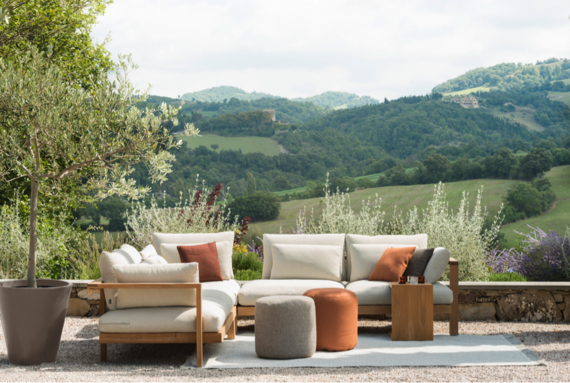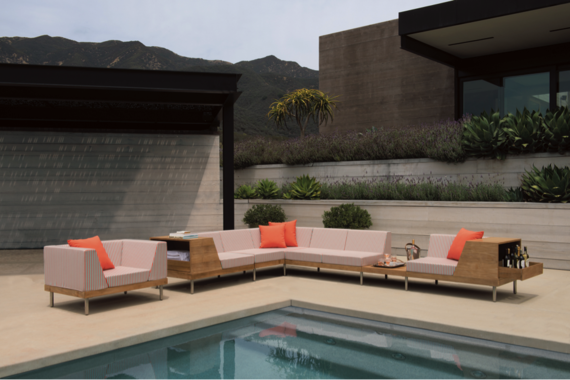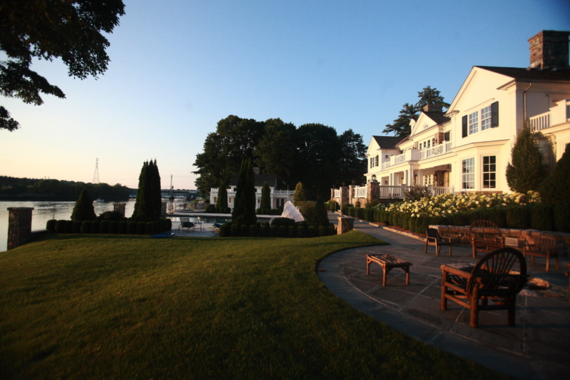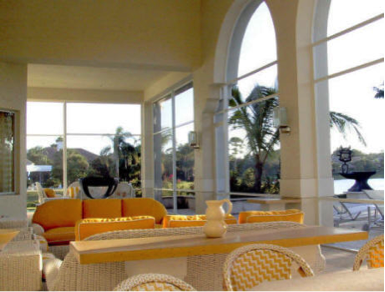Your outdoor space should be chic, sharp, and one of casual sophistication extending throughout the home, from inside to outside. Fabrics and materials, once only used inside, are now gracefully employed on the porch. And furniture that was to be used for one summer season is now valued as a more long-term investment. Here are my Top 7 Tips for Designing your Outdoor Space:
1. Make sure that your outdoor furniture relates to both the style and color of the house's exterior.
If your house is modern, it is wise to place clean, simple, and elegant pieces that conform to the outside linearity. In addition, almost any color furniture relates well to a white/white-washed siding, but if the brick or siding is another color, make sure the pieces complement what exists.
2. Make it an extension from interior to exterior.
The goal is to seamlessly integrate outside with inside, so that the style and color of the interiors extend to the theme and palate of the outdoors. Similar to our first tip, we are creating a continuity of gesture and look between surfaces and planes. If there is traditional furniture within, then a more traditional style would look better outside than a modern style.
3. Create specified areas of conversation for lounging and dining.
If possible, there should be one designated area for eating--perhaps a small round table and 4 chairs on one side of your patio--and another area that provides seating for relaxation and social chatter. However, each of the separate areas should relate to one another. For example, if you use gray furnishings on one side for the lounge areas, stick with that color scheme on the other for dining, etc.
4. Flora and fauna can be just as important to a space as any other design element.
As for incorporating flora and fauna into the exterior design, Janice Parker of Janice Parker Landscape Architects says it best: "When designing an outdoor space, every element of a design matters - edges and transitions, corners, intersections, plants, scents, sounds and importantly, the quality of the light. In large and small landscapes human needs are the same - outdoor spaces must be comfortable, welcoming, invite interaction and communication." Janice successfully integrates her plantings by making them a part of the big picture!
5. What are all of these exterior enhancements worth without proper lighting, especially at night?
Bébé Regnier of Lampworks, NY, says that one should consider using low voltage LED "Dark Sky" lighting. It is now actually a law in some areas, like the Hamptons and Arizona. Basically, the idea is that by using pools of soft light that are cast downward onto the landscape. "There is no uplighting," Bébé notes - "no light pollution and, therefore, no glare" into the beautifully starlit skies, but soft pools of gentle light that are used around your house for more effective purposes.
6. In terms of color, larger pieces work better in neutral palates that are accented by pops of bold color.
This bold accent color reflects the variety of summer fruits and vegetables, and can be incorporated into decorative pillows, tableware, or other accessories. For instance, if the table and chairs are greige or gray or white, adding orange or yellow placements on the table can enhance the quieter, neutral furniture. These pops of color can also relate to the flora and fauna placed around the house.
7. Durable, well-made furniture is essential to bearing up against the elements.
Metals and painted surfaces that used to suffer from inclement summer storms are now coated to hold up against any type of weather. Synthetic materials, that look anything but, are additionally employed to be resistant. JANUS et Cie, for example, has added Weather Teak to many of their existing natural teak collections. And, of course, there are now a plethora of outdoor fabrics from which to choose that both complement and enhance the sophistication of exterior furniture. No longer is it necessary to use canvas-like fabrics; rather, we are offered weather resistant plush chenilles and velvets, should we so choose. There is a demand for higher quality longer-lasting outdoor pieces that last through and for many seasons. This means that the furniture needs to fit a casual and chic profile (in other words - look good), and it also needs to endure. That is to say, it is both an aesthetic and functional investment.



